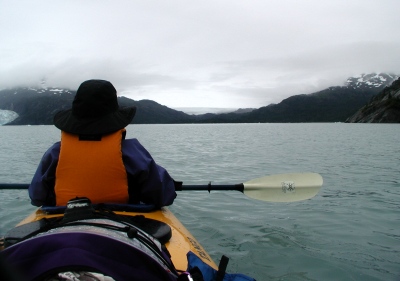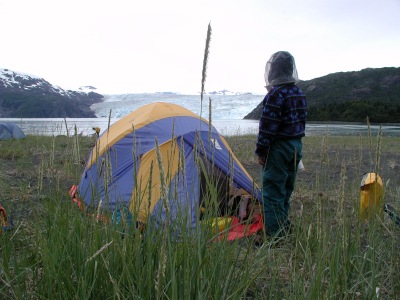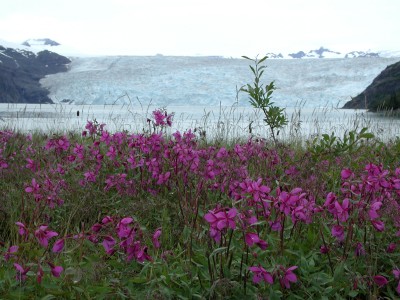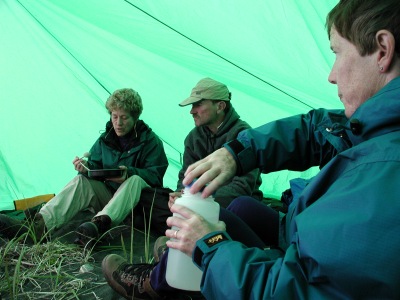Glacial Thunder: Sea Kayaking
in Prince William Sound 2001
Into Nassau Fjord
Thursday, August 16 We awoke about 6:30 to Alaskan mist. It was misting loud enough to hear on the tent fly, and since we did not have far to go, it was a great time to roll over and enjoy the new sleeping bag that Susie had gotten me for my birthday: a Feathered Friends bag overstuffed with down and covered with a water repellent material. So toasty on an ugly morning. This mist stopped in about 45 minutes, and it was time to greet the day. We all squeezed under the tarp that was up: cosy but welcome. Staying out of the wet makes a huge difference in one's attitude. The bugs must have liked it too, since they were under the tarp, attempting to dine as well. Thank god for bug nets. Everyone seemed to be in slow motion this morning: since we had altered our campsite schedule, our paddling only amounted to about 5 miles today. We all agreed to be ready to go at the luxurious hour of 11 am. As we were packing up, I happened to notice some movement in the water off the beach, about 100 yards to our south: something moving that looked more like a log with ears. No sea otter this, for sure. We all realized at the same time that this was a large black bear, who must have been completing a minimum 1.2 mile swim across Icy Bay (that is the shortest distance you could swim around there). It was incredible. He neared shore, got his legs under him, walked up on the beach, shook himself off, and sauntered into the woods, looking more like he had been out for his morning exercise routine.
 Everyone seemed to be ready to roll by 10:40 - there is only so much luxury one can stand, I guess. We headed over to what Diane remembered being a Kittiwake rookery on the south side of the entrance to Nassau Fjord, passing a seal on our right, and a small whale (baby killer whale or dolphin?) on our left. This turned out to be one of the very few times that Diane's memory was off: the rookery turns out to be in Gaanaak Cove, on the north side of the entrance to the Fjord. Without kittiwakes to watch, we altered our course to come into the Fjord on its east side, since "everyone" says that the ice can be really thick on the west side. As we were crossing the mouth, we noticed a group of about 4 other kayaks, around the east side of the entrance. We paddled on over to them, and they turned out to be a group being guided by North Star, the same one we had noticed camped on a nice spot to the SW of the entrance to the Fjord. They were doing a bit of day paddling: the guide seemed to have a smile on his face, but I could not say the same for all the participants. Fun was not written on their faces. Who knows, maybe their expectation of Alaskan weather was continual blue skies and sunshine. They were the group that was being picked up at the same spot as we would be on Saturday, about 4 - 5 hours ahead of us.
Everyone seemed to be ready to roll by 10:40 - there is only so much luxury one can stand, I guess. We headed over to what Diane remembered being a Kittiwake rookery on the south side of the entrance to Nassau Fjord, passing a seal on our right, and a small whale (baby killer whale or dolphin?) on our left. This turned out to be one of the very few times that Diane's memory was off: the rookery turns out to be in Gaanaak Cove, on the north side of the entrance to the Fjord. Without kittiwakes to watch, we altered our course to come into the Fjord on its east side, since "everyone" says that the ice can be really thick on the west side. As we were crossing the mouth, we noticed a group of about 4 other kayaks, around the east side of the entrance. We paddled on over to them, and they turned out to be a group being guided by North Star, the same one we had noticed camped on a nice spot to the SW of the entrance to the Fjord. They were doing a bit of day paddling: the guide seemed to have a smile on his face, but I could not say the same for all the participants. Fun was not written on their faces. Who knows, maybe their expectation of Alaskan weather was continual blue skies and sunshine. They were the group that was being picked up at the same spot as we would be on Saturday, about 4 - 5 hours ahead of us.
 From that point, it was less than an hour's paddle to camp. There were lots of room-sized icebergs visible on our way in, but no small ice to work our way through. Very easy paddling. Susie and I had been with the pack most of the time, and then Tim and Diane just took off. Seems like Tim's prostate must be expanding just like that of the rest of us 50+ males, and he had to pee bad. They probably put a quarter mile on us in a matter of moments. While Diane was not quite sure where the "official" campsite was, it did not really make any difference: Tim had to go, and the beach on the northeast corner of the Fjord must be well over a half mile long, and there are tons of places quite suitable for camping. The beach is like a real beach, covered with black sand known as Graywacke. It is pronounced with a long "e" at the end by some folks, but the official dictionary doesn't recognize the long "e." But I tell you, it did start to drive us wacky after a while. When wet, it sticks to everything. Anyway, we pulled up on the beach well before 12:30, just in time for lunch. The big decision was which of the hundred or so perfect spots would be best to set up a tent: the area was immense. Susie decided that she could not bear to trample down any more of the dwarf fireweed, so we set up our tent on the graywacke. Boy, this kayaking is great: two hours from one camp to the next. And the scenery was just magnificent. We were camped directly across, albeit 2.3 miles or so, from the face of the Chenega Glacier. This is no small chunk of ice. The face of the glacier is about 1.5 miles across. The initial vertical rise is 300 feet, after which it leans only slightly over for another couple of hundred feet. And it was calving like it was a hot summer day. Every minute or two, there would be a huge roar. Of course, by the time you looked, it was 12 - 14 seconds from when the calving had occurred, and you missed the fireworks, so to speak. The alternative was to just stand in awe and watch. It was so impressive.
From that point, it was less than an hour's paddle to camp. There were lots of room-sized icebergs visible on our way in, but no small ice to work our way through. Very easy paddling. Susie and I had been with the pack most of the time, and then Tim and Diane just took off. Seems like Tim's prostate must be expanding just like that of the rest of us 50+ males, and he had to pee bad. They probably put a quarter mile on us in a matter of moments. While Diane was not quite sure where the "official" campsite was, it did not really make any difference: Tim had to go, and the beach on the northeast corner of the Fjord must be well over a half mile long, and there are tons of places quite suitable for camping. The beach is like a real beach, covered with black sand known as Graywacke. It is pronounced with a long "e" at the end by some folks, but the official dictionary doesn't recognize the long "e." But I tell you, it did start to drive us wacky after a while. When wet, it sticks to everything. Anyway, we pulled up on the beach well before 12:30, just in time for lunch. The big decision was which of the hundred or so perfect spots would be best to set up a tent: the area was immense. Susie decided that she could not bear to trample down any more of the dwarf fireweed, so we set up our tent on the graywacke. Boy, this kayaking is great: two hours from one camp to the next. And the scenery was just magnificent. We were camped directly across, albeit 2.3 miles or so, from the face of the Chenega Glacier. This is no small chunk of ice. The face of the glacier is about 1.5 miles across. The initial vertical rise is 300 feet, after which it leans only slightly over for another couple of hundred feet. And it was calving like it was a hot summer day. Every minute or two, there would be a huge roar. Of course, by the time you looked, it was 12 - 14 seconds from when the calving had occurred, and you missed the fireworks, so to speak. The alternative was to just stand in awe and watch. It was so impressive.
 Golly, what does one do with all this extra time? Well, sun bathing did not seem to be a good option today: kinda dreary, with occasional mist, and then it would lighten up a bit. By the time we unloaded the kayaks, hauled them up above the high tide line, got the tent set up, the gear situated, lunch eaten, it was getting on to 2 o'clock. Next it was time to find water. Interestingly, the obvious creek at the northeast end of the beach did not seem to have any water in it, although a low tide exploration of the area indicated that water was flowing out of the sand below the water line most of the time. Diane and Tim headed south along the beach and found the best water source of the trip: a lovely little stream filling a grotto. It was surrounded by salmon berries, so you could munch while waiting for your water bag to fill. I went to the north end of the beach, and with some rock scrambling, managed to get around the head of a small cliff, that might be tough to cross at high tide. I thought I would try to find the little lake at the north end of the fjord, but it did not take me long, once I started getting into the vegetation, to realize that this could turn into another "nature walk," like that on Sunday. I opted to look harder, maybe tomorrow. Back down at the creek, while I was cleaning up, I was watching the glacier when it split off a huge ice spire that must have been 250 - 300 feet high. The splash that it made will be something to remember. The roar just added to the spectacle.
Golly, what does one do with all this extra time? Well, sun bathing did not seem to be a good option today: kinda dreary, with occasional mist, and then it would lighten up a bit. By the time we unloaded the kayaks, hauled them up above the high tide line, got the tent set up, the gear situated, lunch eaten, it was getting on to 2 o'clock. Next it was time to find water. Interestingly, the obvious creek at the northeast end of the beach did not seem to have any water in it, although a low tide exploration of the area indicated that water was flowing out of the sand below the water line most of the time. Diane and Tim headed south along the beach and found the best water source of the trip: a lovely little stream filling a grotto. It was surrounded by salmon berries, so you could munch while waiting for your water bag to fill. I went to the north end of the beach, and with some rock scrambling, managed to get around the head of a small cliff, that might be tough to cross at high tide. I thought I would try to find the little lake at the north end of the fjord, but it did not take me long, once I started getting into the vegetation, to realize that this could turn into another "nature walk," like that on Sunday. I opted to look harder, maybe tomorrow. Back down at the creek, while I was cleaning up, I was watching the glacier when it split off a huge ice spire that must have been 250 - 300 feet high. The splash that it made will be something to remember. The roar just added to the spectacle.
 While the bugs were not as bad here, probably because of the weather, there were more than enough to be annoying, and required the use of bug nets. It seemed like a good time to erect our three sided tarp - the one with mosquito netting across the front. I figured that while we could not cook inside, all seven of us could eat bug free, and wouldn't that be a nice treat. Susie and I got inside around dinner, determined to enjoy ourselves. Most of our long suffering friends could not stand to partake of such luxury so soon, but Dave, perhaps our resident hedonist, recognized a great idea when he saw it. Soon, everyone had squeezed into the lean to, and we could all see each other's faces. Another advantage was that the tarp really broke the wind (actually breeze, but when the temperature hovers around 50 degrees, any air movement feels like wind) and captured the heat of the seven bodies. Had I sat long enough, I think I could have consumed all of our wine. Good friends, hot tasty food, a bit of the grape, and nowhere we had to go tomorrow. Sure it looked like it might sock in forever, but maybe the morning would bring something different. We built a small fire outside the tarp, but soon the mist started up, and bed sounded better and better.
While the bugs were not as bad here, probably because of the weather, there were more than enough to be annoying, and required the use of bug nets. It seemed like a good time to erect our three sided tarp - the one with mosquito netting across the front. I figured that while we could not cook inside, all seven of us could eat bug free, and wouldn't that be a nice treat. Susie and I got inside around dinner, determined to enjoy ourselves. Most of our long suffering friends could not stand to partake of such luxury so soon, but Dave, perhaps our resident hedonist, recognized a great idea when he saw it. Soon, everyone had squeezed into the lean to, and we could all see each other's faces. Another advantage was that the tarp really broke the wind (actually breeze, but when the temperature hovers around 50 degrees, any air movement feels like wind) and captured the heat of the seven bodies. Had I sat long enough, I think I could have consumed all of our wine. Good friends, hot tasty food, a bit of the grape, and nowhere we had to go tomorrow. Sure it looked like it might sock in forever, but maybe the morning would bring something different. We built a small fire outside the tarp, but soon the mist started up, and bed sounded better and better.
© Roger A. Jenkins & Suzanne A. McDonald, 2001
